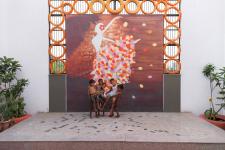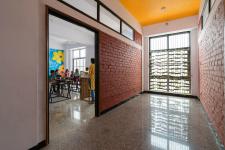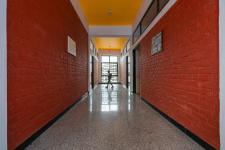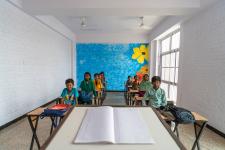To new and naïve eyes, the site surroundings of this project would look like an elegant assembly of dark hills with the school building sitting in their valley. In grave reality, these hills are just humongous piles of garbage coming from major parts of the city and decaying there for over a decade. This is one of Delhi’s largest dumping grounds in Bhalswa. The more fortunate city-gentry has inherently declared this location as a social-reject, and visiting it, a taboo. It might come as a shock to some that there is a well populated community living along these trash hills only to make ends meet from rag-picking.
On a curious thought, what would childhood be like for little children growing up here? Perhaps, playing around with friends over heaps of junk and creating toys from their rag-picking findings? Their story must be delightful, but its setting, very alarming and outrageous. At tender ages, they are exposed to grave incidents of trafficking, sex rackets, theft and unspeakable crime cases. Not to forget the immense health hazard caused by just breathing toxic air. For a child living here, future only appears more dark and dingy by the passing day. This situation was realized by an NGO run by fathers and priests. What seemed like an unflinching target shot was to strengthen their community through an informal institution & educating those who had their skin in the game.
For a context as grim as this, there was no space for scenic views or any architectural intervention that could make it less ghastly. It was thus decided to not even attempt at competing with the context. This building was designed “inward”. This meant that the building was not intended to add value to the dump yard. The school had to be an embodiment of escape from reality or a discreet wonderland where kids were allowed to dream. The enclosed design was hopeful of reducing outside smell and openings had green interventions to filter air flowing in. Following this, all the rooms were planned facing an inward courtyard which became the school’s heart and soul. Material for furniture and decorative items, like ropes, tires and upcycled planters were all sourced from its surroundings and the classrooms hand-painted by its students. A rope mesh looped over the courtyard as a protective measure against vultures dropping objects inside.
The entire site is lower than the existing road level, so the building’s base was raised to get some elevation and avoid flooding during monsoons. Due to the location being deprived of basic nearby amenities, the structure has to run on its own energy powered by solar panels and have its sanitary requirements fulfilled by rain-water harvesting. Apart from informal schooling, there are many women empowerment workshops, sewing classes, skill development classes taking place to raise community awareness. The difference may not be evident and immediate, but architecture has potential to change lives and as long architects are attempting at it, the benefit would surely be immense and abiding.
2019
2020
Project Name: School in the Dumpyard
Office Name: Myspace Architects
Office Website: https://www.myspacearchitects.com/
Contact email: [email protected]
Firm Location: Noida, Delhi NCR, India
Completion Year: 2021
Gross Built Area (m2/ ft2): 700 sqm
Project location: Bhalswa, Delhi, India
Program: Child Resource Center
Architect- Ar. Alex Joseph
Architectural Critic- Ar. Dona Kurian
Design Development-Ar. Rijul Nayal
Design Detailing-Danny Chacko Mathew
Graphics-Nishu Prasad
Publishing Content preparation-Ar. Hania Rizwan
Structure Consultant- Er. Noble P Thomas/ Srishti Projects Pvt Ltd
Electrical Consultant-Er. Rajasekhar Koneru/PPES
PHE Consultant-Deepak Khosla/Khosla Associates
Civil Contractor-Er. Joseph Cherian & Ravi/Cherian & Sons
Wood work-Shantiprasad Semwal/Bajrang Interiors
Photography-Ar. Tushar Garg/Techfrog














